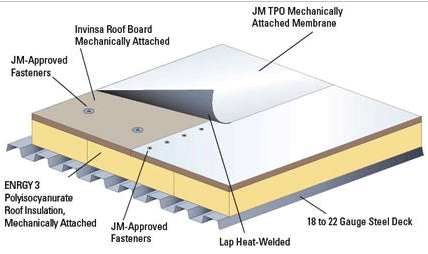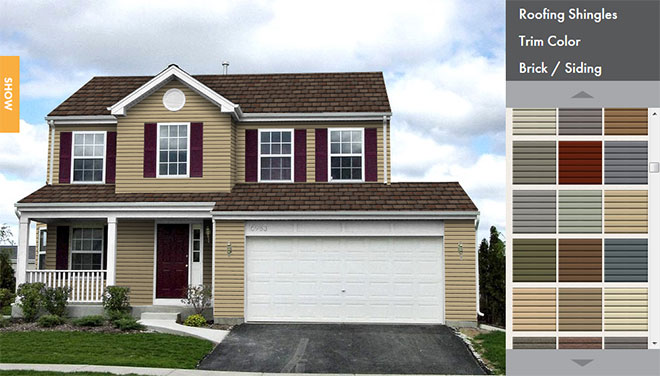TPO Roof System
TPO roofing membrane is typically based on polypropylene and EP (ethylene-propylene) rubber polymerized together using state-of-the-art polymer manufacturing technology. This technology enables the production of TPO membranes that are flexible at low temperatures without the use of polymeric or liquid plasticizers.
Unlike some other popular thermoplastic roofing membranes, the TPO polymer does not contain chlorine and no chlorine-containing ingredients are added during sheet production. This lack of chlorine has allowed TPO marketers to tout their membrane as an environmentally safe, “green” product.
The TPO resin is compounded with other components including a weathering package, fire retardants and pigments for color to create a product that can withstand the elements associated with rooftop exposure. The membrane is comprised of TPO based top and bottom plies encapsulating a reinforcing fabric that enhances the physical properties of the sheet. The combination of the fabric and TPO plies provide reinforced membranes with high breaking and tearing strength and puncture resistance. Sheet widths are available up to 3.66 m (12 ft) and membrane thickness is typically 1.1 or 1.5 mm (0.045 and 0.060 in.), however, membrane up to 2.0 mm (0.080 in.) is available.
Installation/System Types
TPO roofing membrane is typically installed using mechanical fasteners and plates placed along the edge of the sheet and fastened through the membrane and into the roof decking. Adjoining sheets of TPO membrane are overlapped, covering the fasteners and plates, and joined together with a minimum 40 mm (1 1/2 in.) wide hot air weld.
In the field of the roof, proper membrane width and fastener spacing is determined after calculating potential uplift loads based on building height, surrounding terrain and the wind zone in which the building is located. The fastener/deck combination must exhibit adequate pull-out resistance to withstand the fastener loading generated during uplift. The membrane and the welded seam must also resist the forces generated by wind uplift. The ability of a mechanically fastened system to withstand these forces is typically evaluated using a 3.7 x 7.3 m (12 ft x 24 ft) uplift table where the system may be pressurized until failure. Along the perimeter of the roof, where the highest wind loads are experienced, reduced width membrane (40 to 60 percent of the field sheet width) is installed to reduce the fastener and seam loading.
The membrane may also be fully adhered to an insulation or deck material using an adhesive. Insulation is typically secured to the deck with mechanical fasteners and the TPO membrane is adhered to the insulation. This type of system is highly resistant to wind and its associated uplift forces. Since the sheet is 100 percent affixed to the substrate, the membrane does not flutter due to associated wind forces. With no sheet movement due to the 100 percent attachment of the membrane, the fully adhered system is ideal for very visible roofs such as domes or other high slope applications.
Weldability
One of the primary benefits of TPO membrane is the ability to fuse the sheets together with a hot air weld. The welding process results in a bond that is actually stronger than the sheet itself. Flashing details, such as exhaust vents, pipes and parapet corners are also completed using hot air welds and flashing material (typically non-reinforced).
When properly compounded, TPO membrane has a wide window of weldability, allowing the roofing applicator to complete hot air welds consistently in a broad temperature range. Since weld integrity is critical to the performance of the roofing system, it is imperative that the membrane welds properly in a wide range of ambient temperatures. TPO membrane can be welded at speeds up to 80 mm/s (16 ft/min) using a self-propelled hot-air welder, however, optimum welding speeds are 60 to 70 mm/s (12 to 14 ft/min) with the air temperature at the welding nozzle at approximately 540º C (1000º F). TPO is a thermoplastic material and does not “cure” on the rooftop once installed. This allows the sheet to be repaired with proper surface preparation after rooftop exposure.
Wide Sheet Technology
Another benefit that TPO membranes brought to the roofing community were wide width sheets. Currently, TPO membrane is available in the market in widths up to 3.66 m (12 ft). These wider sheets provide installed cost savings by reducing the total number of seams to be completed in the field and the labor associated with the seaming/welding process. Wider sheets also require fewer fasteners and plates for membrane securement, fewer rolls for the roofing applicator to handle on the roof, and less membrane being utilized in the seam overlaps.
Physical Properties
The ASTM specification for TPO roofing membranes outlines a variety of physical properties and their minimum performance requirements. These properties include top ply thickness over scrim, elongation, breaking strength, tearing strength, linear dimensional change, weatherability and a myriad of others. Establishing these minimum requirements will provide a guideline for sheet manufacturers and will help ensure TPO membrane produced under this specification provides long-term rooftop performance.
Thickness of top-ply coating over scrim is a very important element of the roofing membrane and has a direct effect on a sheet’s ability to provide long-term weathering, abrasion resistance and weldability. The top ply thickness is measured at the intersection of reinforcing fibers. Breaking and tearing strength are also critical properties since each has a direct influence on the performance of the membrane when subjected to wind uplift forces.
TPO Single – Ply Roof System – JM TPO/JM TPO-1

The Johns Manville TPO roofing systems combine both polypropylene (plastic) and ethylene-propylene (rubber) using state-of-the-art polymer manufacturing technology.
The result is an ideal commercial roof system that is reliable and cost effective. The TPO system is one of the latest single-ply, flat roofing technologies on the market today.
Properly installed TPO roof systems have service lives ranging from about 10 to 20 years, depending on the type of installation. Full removal of the existing roof, the amount of slope the roof has, weather conditions, as well as several other criteria contribute to the longevity of a roof’s service life. Typically, if you remove an old roof down to the deck before installing a new one, then the new roof will last longer. Also, the steeper the slope and the less severe the weather conditions, the longer a roof will last. High winds and hail can do a roof in rather quickly.
But remember, the number one ingredient to a good roof system is proper installation.


 Click Here
Click Here Click Here To Use
Click Here To Use